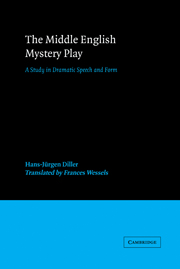Book contents
- Frontmatter
- Contents
- Preface
- Note on texts used
- Abbreviations and special symbols
- Introduction
- Part I The foil: Latin church drama
- 1 Liturgy and drama
- 2 Liturgical point of view surrounding the dramatic core dialogue
- 3 ‘World-containing’ situations
- 4 The dramatization of narrative sources
- Part II The English Creation to Doom cycle
- Notes
- Bibliography
- Indexes
3 - ‘World-containing’ situations
Published online by Cambridge University Press: 04 March 2010
- Frontmatter
- Contents
- Preface
- Note on texts used
- Abbreviations and special symbols
- Introduction
- Part I The foil: Latin church drama
- 1 Liturgy and drama
- 2 Liturgical point of view surrounding the dramatic core dialogue
- 3 ‘World-containing’ situations
- 4 The dramatization of narrative sources
- Part II The English Creation to Doom cycle
- Notes
- Bibliography
- Indexes
Summary
Origins and character of the new situation-type
In the scenes treated so far the basic liturgical structure was still recognizable. Notwithstanding their historical ‘rôles’, the ‘actors’ behaved as liturgist and congregation, as Revealers and Recipients. Between the two parties no relationship existed other than that established by the act of Revelation.
The type of the Revelation scene was left behind for the first time when the encounter between Herod and the Magi was included in the eleventh century. Like the scenes previously discussed, this too has its liturgical forerunners, in this case the responsories:
Magi ueniunt ab oriente, Ierosolymam quaerentes, et dicentes: Ubi est qui natus est, cujus stellam vidimus, et venimus adorare Dominum
and
Interrogabat Magos Her odes: Quo d signum vidistis super natum Regem? Stellam magnam fulgentem, cujus splendor illuminat mundum; et nos cognovimus et venimus adorare Dominum.
These responsories accompany the Rouen Officium Trium Regum. They retain their narrative form and disregard the turn-taking of the speakers correspondingly. But the same office contains a completely ‘dramatized’ dialogue between the Magi and duo de maiori sede cum dalmaticis who have been introduced, as in other Officia Stella, in obvious analogy to the Midwives of the Officia Pastorum.
The Rouen texts which have come down to us do not go back beyond the thirteenth century, but there are earlier texts from other cities which not only are fully dialogued but also show a remarkable independence of the liturgy. In the eleventh-century text from Freising (Young, DMC, vol. 2, pp. 92–7), the variety of spatio-temporal and interpersonal relationships in the encounter between Herod and the Magi, the raging of Herod, and the orthodox hexameters clearly suggest non-liturgical influence.
- Type
- Chapter
- Information
- The Middle English Mystery PlayA Study in Dramatic Speech and Form, pp. 33 - 53Publisher: Cambridge University PressPrint publication year: 1992



